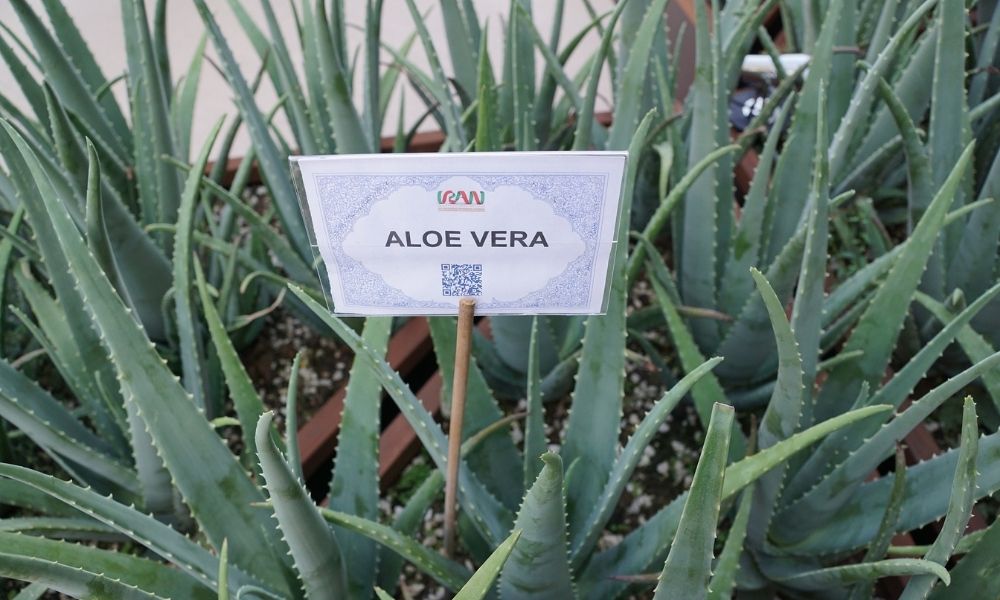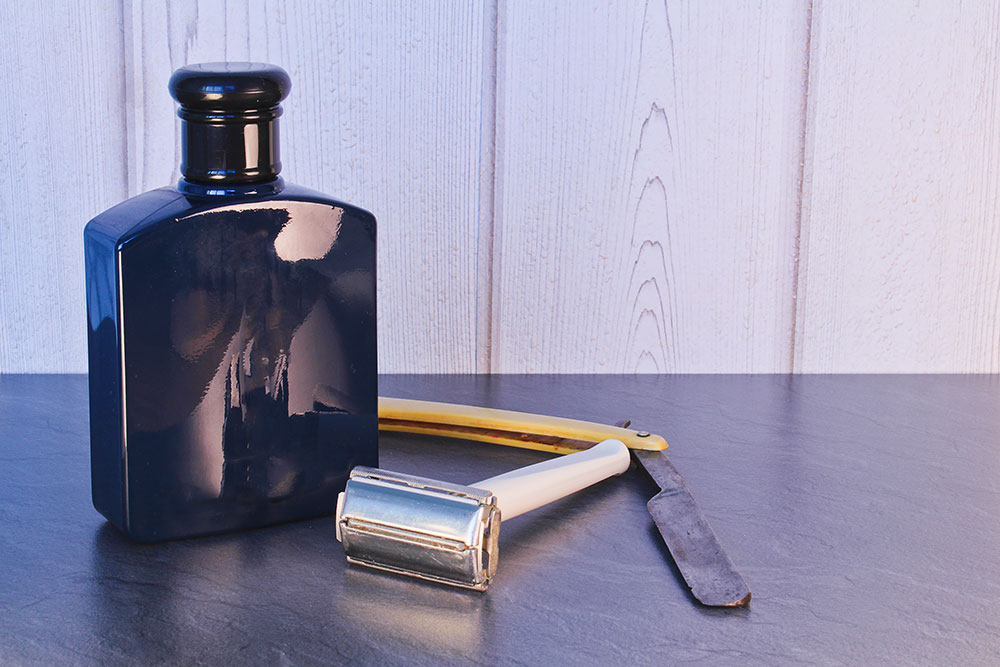Ever wondered “exactly what does aftershave do?” Today, we’ll hit topics like the purpose of aftershave, why it burns, and whether it’s even necessary at all. Stay tuned, shavers!
View in gallery
Believe it or not, the shaving of facial hair dates back to the Stone Age, when men used clamshells as tweezers to pull out hair. While shaving has gone on for over 60,000 years, we largely have the Romans to thank for aftershave.
Roman barbers used a mixture of spider webs soaked in oil and vinegar to deal with infections that developed after a shave. The acidity in the vinegar cleaned the shaved area, and the oil kept the skin smooth.
In modern times, aftershave has become more commonplace and a ritual for some, not only at the barbershop but also at home.
In this article, we will talk about everything you need to know about the aftershave. We will touch on what the point of aftershave is, the types of products available, common ingredients to look out for, whether it is actually necessary, and of course, how to use it.
Table of Contents
What Is Aftershave?
Aftershave is any liquid, gel, paste-like, or oily substance you apply after shaving for the purpose of soothing irritated skin. It can have a variety of different ingredients, which determine what the aftershave does for your skin.
The traditional alcohol-based aftershave splashes only disinfect the shaved area. Others with oils soothe the irritated shaved area and keep your skin hydrated. We will let you know what ingredients to look out for later in this article.
What Does Aftershave Do?
As mentioned above, not all aftershaves are the same nor do they do the same thing. Some have more benefits than others. However, your aftershave should at least perform one or all the following.
Prevent Infection
Routine and especially occasional shaving can be rough on the skin, even with a super-sharp blade or blades. It often leads to damage of the top layer of the skin and exposes skin pores to bacteria. Tiny cuts form as you try to cut close to the skin to remove all visible hairs. They may also develop because of friction between the razor blade and your skin.
Whatever the case, these tiny cuts open the door to infections. This is why all aftershaves should have antiseptic properties to disinfect the shaven area to prevent bacterial or fungal infections.
That said, avoid alcohol-based aftershaves made using isopropyl alcohol (isopropanol) or ethyl alcohol. They cause drying of the skin and even poisoning when used for extended periods. Instead, look for aftershaves made using witch hazel and tea tree oil, which are both plant-based and have antiseptic and anti-inflammatory properties.
Tighten Pores
Have you ever noticed red and itchy bumps after shaving? If you have, you probably have or had folliculitis. It happens when hair follicles become irritated during shaving, and the pores remain open after shaving, allowing bacteria, fungi, or other chemicals to infect the area.
Some aftershaves have astringent properties that tighten pores and create a poor environment for the growth of bacteria and fungi.
The astringent quality also helps reduce and eventually stop bleeding by constricting blood vessels. An aftershave can also cover the hair follicle openings, reducing infections that cause itchiness and soreness.
Soothe Irritation and Moisturize Skin
View in gallery
Shaving causes skin irritation which can leave the area itchy. An aftershave with anti-inflammatory properties can reduce this skin irritation. It should also keep your skin hydrated, smooth, and healthy.
Leave You With a Refreshing Scent
While not all aftershaves have a fragrance, who doesn’t want to smell good? Having one can leave you feeling refreshed and more confident.
Aftershaves have a variety of scents, some with natural fragrances from lavender oil, anise, oatmeal, cedarwood, etc.
A strong or faint scent, or whatever you fancy, accompanied by a freshly shaved beard, is always a plus in our books.
Is Aftershave Necessary?
For the most part, yes.
Shaving often leads to cuts and wounds, which can get infected without any intervention. An aftershave helps prevent infections and soothes irritated skin. In some cases, it can moisturize and refreshen skin depending on the ingredients present.
If you use an electric trimmer, aftershave isn’t really necessary as the blades usually don’t run so close against the skin as to cause damage. Additionally, if you’ve just done a quick shave with a traditional wet razor to fight off that 5 o’clock shadow, you’ll be fine skipping the aftershave if you’re in a hurry and didn’t nick yourself.
Generally, the harder the shave job (aka, the longer/thicker the beard hair you’re dealing with) the more likely you are to experience irritation that aftershave can help alleviate.
How to Use Aftershave
Now that we have covered the basics of what aftershave is for, let us learn how to use it the right way.
View in gallery
- Complete your shaving routine as usual.
- Wash your face or the shaven area with cold water. Ensure you remove all the remaining shaving cream or lotion used.
- Pat the shaved area with a clean towel to remove excess water, making sure not to rub the towel on the skin. Rubbing can cause the skin to get more irritated and damaged.
- Pour a small amount of your choice of aftershave. The amount should be about the size of a dime. If using an aftershave balm, scoop a fingertip-sized amount.
- Rub the aftershave in a circular motion between both hands to spread it evenly.
- Apply the aftershave gently on the shaved area. Ensure you cover the entire section evenly and massage it until completely absorbed by your skin.
- If using a splash, you may massage some balm or moisturizer on the area to reduce the drying effect of the alcohol on your skin.
- Leave it in until your next bath, shower, or shave.
A little aftershave goes a long way in helping your skin after shaving. Avoid slathering loads of aftershave on your face, as this can cause more irritation, leave your skin greasy, or even clog pores.
Need a recommendation on which aftershave to use? Here’s our list of the most soothing aftershaves for men.
What Is in Your Aftershave?
Aftershave has several ingredients. We cannot include all of them, but here is a breakdown of some frequently used components, what they do, their benefits, and their effects on your skin.
Alcohol
It is present in some aftershaves and sterilizes the shaven area, keeping infections at bay. It also has astringent properties that tighten the skin and pores, providing an unsuitable environment for bacteria.
Despite these properties, alcohol used in aftershaves reduces the production of sebum. Sebum naturally helps protect and moisturize skin. A decrease leads to dry skin, which explains why alcohol-based aftershaves leave your skin feeling dry.
Also, the alcohol component in the aftershave results in a sharp sting or burn when it comes into contact with the cuts and abrasions on the post-shaven skin.
Witch Hazel
It is a natural alternative to alcohol in aftershaves. It fights bacteria, constricts pores, and has anti-inflammatory properties that effectively deal with irritation and itching experienced after shaving. It can also repair skin, helping it return to health in no time.
Unlike alcohol, it does not cause a noticeable burn when applied on raw skin or cause skin to feel dry.
Glycerin
Glycerin acts as a humectant, and this is why it is popular with cosmetic manufacturers. It prevents moisture loss in the skin by absorbing surrounding water and keeping it within the skin. The humectant property helps keep your skin fresh, moist, and soft.
Shea Butter
Shea butter comes from the nut of the African Shea tree. It has moisturizer qualities that keep your skin soft and hydrated. Other moisturizing oils include coconut and jojoba oil.
Essential Oils
These are compounds extracted from plants for aromatherapy purposes. Watch out for the unscientific claims of the many healing and soothing properties some essential oils have.
Examples of essential oils used to make aftershaves are lavender and eucalyptus oil.
Aloe Vera
View in gallery
We cannot sing enough praises about Aloe Vera. In an aftershave, it acts as a natural antiseptic, soothes razor burns, repairs surface cuts, all the while helping your skin retain its moisture.
Other Ingredients To Look Out for
- Chamomile extract for soothing skin.
- Tea tree oil reduces infections and skin irritations.
- Vitamin E oil for moisturizing skin and keeping it healthy.
- Calendula oil for repairing broken skin, preventing fungal and bacterial infection, and reducing skin irritation.
Types of Aftershaves
Aftershaves mainly come in three types: balm, lotion, or splash. Let us look at them in greater detail to see their differences and how to choose the right one for you.
Aftershave Balm
An aftershave balm has a lotion-like to thick and semi-solid consistency, which makes application convenient. It has little to no alcohol content, so you will not experience a sting when you apply it. It also has a mild scent, and in some cases, no scent at all.
It moisturizes and refreshes irritated and damaged skin after a shave. It can also help reduce razor burns. As an added advantage, you can also use an aftershave balm to soothe and heal sunburned skin.
The balm is suitable for all skin types but is ideal for sensitive skin because of the minimal to no alcohol content and fragrance. It is also excellent for shavers in cold and dry climates.
Related Reading: Beard Balm vs. Beard Oil
Aftershave Lotion
An aftershave lotion has a creamy, light, and sometimes runny consistency. It typically does not contain alcohol, but you can find a bit of alcohol in some aftershave lotion brands. Expect a slight burn on application with alcohol-based aftershave lotions.
Lotions come with a more distinct fragrance than balms, but it is mild enough to pair with a body spray or cologne.
It helps keep the skin moist, soft, and smooth by reducing dryness.
Aftershave Splash
The aftershave splash has a water-like consistency. It has the highest alcohol content of up to 75% in some aftershaves.
The alcohol cleanses shaved areas, stops bleeding from nicks and cuts, and tightens pores to prevent bacteria and fungal infections. The high alcohol concentration also means you will experience a harsh sting when applied to a shaven area with cuts and abrasions.
An aftershave splash has an overpowering scent that can linger for long. It is best to skip on your favorite cologne or body spray when you use an aftershave splash.
Because of the high alcohol content in the splash, the skin tends to feel dry after application. To counter the dryness, apply some aftershave balm to revitalize your skin and keep it soft and hydrated throughout the day.
Other Aftershave Options
The aftershave balm, lotion, and splash are the most common aftershaves used. However, shavers may also come across the following aftershave products.
- Alum block. The alum block is a crystal block of mineral salts. It sterilizes surface nicks and cuts post-shaving. It also helps stop bleeding due to its astringent properties of constricting blood vessels. Like alcohol, the alum block causes skin dryness, so avoid it if you have dry and flaky skin.
- Aftershave gel. This has as a gel consistency. It does not contain oils, so it does not help retain moisture. It, however, soothes and refreshes skin, allowing it to remain healthy after shaving.
How to Choose the Right Type of Aftershave
Your choice of aftershave depends on your skin type and your climatic environment. View in gallery
Aftershave balms work best for shavers in cold and dry environments. If you stay in a humid area, then grab some aftershave splash.
That said, everyone’s skin behaves differently, so you should first and foremost consider your skin type when selecting the right aftershave.
Aftershave Choice Based on Your Skin Type
How do you know what skin type you have? Take a look at this brief guide.
Normal Skin
Normal skin is even-textured, appears smooth and healthy. Men with this type of skin can use the full range of aftershaves.
If you decide to use a splash or an aftershave that is known to cause dryness, always follow up with a moisturizing aftershave balm or a moisturizer to keep your skin refreshed and hydrated.
Also, consider an aftershave that uses witch hazel, which offers all the same qualities as alcohol-based aftershaves without the harshness on the skin.
Oily Skin
This type of skin feels oily when touched. It also appears shiny around the forehead, nose, and chin. It has large pores and easily suffers from blackheads, whiteheads, and pimples.
Men with oily skin should use aftershave splashes.
Dry Skin
Dry skin feels rough when touched. It may also appear dull and chaffed. In other instances, it may be peeling and cracked.
If this describes your skin, use an aftershave balm or lotion with moisturizing and refreshing ingredients such as shea butter, aloe vera, jojoba oil, glycerin, etc.
If you’ve got dry skin, steer clear from products with any alcohol content that will leave your skin dryer after application.
Sensitive Skin
Sensitive skin is prone to a break out of rashes and pimples, which can get itchy when exposed to certain chemicals and compounds in products.
Stick with a balm that has moisturizing properties. It should also have mild to no scent components in the aftershave balm. You can also select an aftershave specifically designed for shavers with sensitive skin.
For sensitive skin, stay away from aftershaves with lemon or eucalyptus oil, as it may cause more irritation, especially when exposed to the sun.
Combination of Skin Types
It is common to find men (and women) with a combination of two or more skin types. If this is the case, you will notice the different characteristics mentioned above on specific areas of your skin.
This should not worry you, and a safe bet for is a non-alcohol-based aftershave lotion.
Frequently Asked Questions
-
Why does aftershave burn?
The skin burns when the alcohol in the aftershave comes into contact with surface nicks and wounds. While the sting may hurt or burn, the alcohol keeps the damaged area free from infections and helps stop bleeding.
-
Can you use aftershave balm as a moisturizer?
Yes, when used immediately after using an aftershave splash post-shaving. No, if you intend to use it as an everyday moisturizer without shaving.
Aftershave balms have moisturizing properties but are designed for short-term use – immediately after shaving and up to two or three hours later. Moisturizing creams and lotions are made for long-term use and can keep skin moist throughout the day.
-
Cologne vs. Aftershave
Aftershave prevents infections and moisturizes skin post-shaving. While some aftershaves have fragrances, this is not their primary task.
On the other hand, colognes keep you smelling fresh for several hours a day. For best results, apply a cologne at pulse points and immediately after a shower.
-
How long does aftershave last?
Aftershave can last up to two to three hours after applying.
-
Can you make aftershave at home?
Yes, it is possible to make your aftershave at home. It may require a bit of trial and error, but there are several DIY aftershave recipes online you can give a try.
Always try out a new concoction on a small patch of skin before applying it to the entire surface.
Final Thoughts
Aftershave should have a place in every man’s bathroom as we have seen that it disinfects, soothes, hydrates, and refreshes the skin after shaving.
We hope you have a better understanding of your skin so that you can choose the right aftershave for your skin and look out for aftershave ingredients that make your skin healthier.
Do you use aftershaves you’d like to recommend or have any questions about what aftershaves do? Feel free to share with us in the comments section below.



